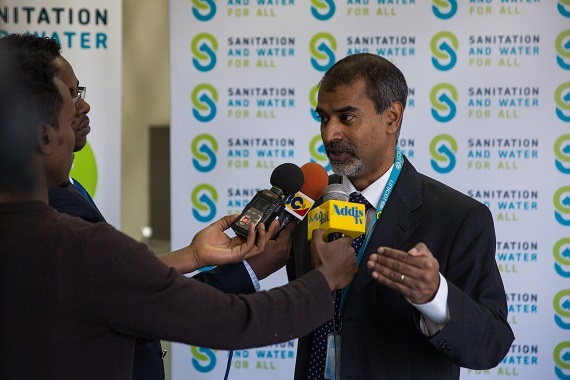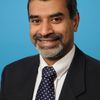
Sanjay Wijesekera speaks to press at the Sanitation and Water for All Ministerial Meeting, Addis Ababa, Ethiopia, March 15, 2016
When it comes to water, sanitation and hygiene, the new Sustainable Development Goals are not going by half-measures.
The SDGs are aiming for 'universal and equitable' access to safe water, sanitation, and hygiene. In other words, for every single person on earth.
In this, they are unlike the Millennium Development Goals which aimed only to reduce by half the proportion of the global population that didn't have adequate drinking water, or have or use toilets.
The MDGs left 663 million people without improved drinking water in 2015, and 2.4 billion people - roughly one-third of the world - without toilets.
In 2015, some 800 children under 5 years old died every day from diarrhoeal diseases caused by the lack of safe water, sanitation and hygiene. Around 159 million children globally were stunted, a condition linked to open defecation.
How do we get from here to there?
Representatives of some 50 countries are in Addis Ababa this week, with the UN, civil society and experts, at the Sanitation and Water for All Ministerial Meeting precisely to plan how to move forward on universal access.
We at UNICEF see this as a crucially important challenge. Simply put, the goals on nutrition, health, education, poverty and economic growth, urban services, gender equality, resilience and climate change cannot be met without progress on water, sanitation and hygiene.
It is clear we can't work in the same old way.
1.Focus on those furthest behind. We can no longer leave out the poorest and most marginalized. The rural poor; those who live in urban slums; ethnic minorities; the disabled; and many women and children were among those left out of the MDGs. We must reach them.
2.Ensure good governance and accountability. It will come down to stronger and better policies, institutions, financing, monitoring systems and capacity development. In Addis, we will agree on how make sure these are in place in each country.
3.Address the impact of climate change: Nearly 160 million children live in severely drought-prone areas, and half a billion in flood prone areas, mostly in Africa and Asia. These climate-linked events exacerbate water scarcity and damage water and sanitation systems, increasing the risk of diarrhoea outbreaks. Other water-borne diseases such as malaria, dengue, zika, and cholera are set to rise with higher temperatures. We must deal with climate change, especially for those already most vulnerable.
4.Use innovation, testing and data. It is 2016, and we have better technology than in 2000. We can test to ensure that safe water is flowing from 'improved' water sources. We can gather data to help governments pinpoint the populations left behind. And we can use new technology to bring better and cheaper toilets, and better and safer water to the millions who don't have them now.
Addis must be our springboard to action, because no one should have to wait for years and years for safe water, proper toilets and better hygiene.
(A version of this article was run by IPS News, March 15, 2016)
Our 2024 Coverage Needs You
It's Another Trump-Biden Showdown — And We Need Your Help
The Future Of Democracy Is At Stake
Our 2024 Coverage Needs You
Your Loyalty Means The World To Us
As Americans head to the polls in 2024, the very future of our country is at stake. At HuffPost, we believe that a free press is critical to creating well-informed voters. That's why our journalism is free for everyone, even though other newsrooms retreat behind expensive paywalls.
Our journalists will continue to cover the twists and turns during this historic presidential election. With your help, we'll bring you hard-hitting investigations, well-researched analysis and timely takes you can't find elsewhere. Reporting in this current political climate is a responsibility we do not take lightly, and we thank you for your support.
Contribute as little as $2 to keep our news free for all.
Can't afford to donate? Support HuffPost by creating a free account and log in while you read.
The 2024 election is heating up, and women's rights, health care, voting rights, and the very future of democracy are all at stake. Donald Trump will face Joe Biden in the most consequential vote of our time. And HuffPost will be there, covering every twist and turn. America's future hangs in the balance. Would you consider contributing to support our journalism and keep it free for all during this critical season?
HuffPost believes news should be accessible to everyone, regardless of their ability to pay for it. We rely on readers like you to help fund our work. Any contribution you can make — even as little as $2 — goes directly toward supporting the impactful journalism that we will continue to produce this year. Thank you for being part of our story.
Can't afford to donate? Support HuffPost by creating a free account and log in while you read.
It's official: Donald Trump will face Joe Biden this fall in the presidential election. As we face the most consequential presidential election of our time, HuffPost is committed to bringing you up-to-date, accurate news about the 2024 race. While other outlets have retreated behind paywalls, you can trust our news will stay free.
But we can't do it without your help. Reader funding is one of the key ways we support our newsroom. Would you consider making a donation to help fund our news during this critical time? Your contributions are vital to supporting a free press.
Contribute as little as $2 to keep our journalism free and accessible to all.
Can't afford to donate? Support HuffPost by creating a free account and log in while you read.
As Americans head to the polls in 2024, the very future of our country is at stake. At HuffPost, we believe that a free press is critical to creating well-informed voters. That's why our journalism is free for everyone, even though other newsrooms retreat behind expensive paywalls.
Our journalists will continue to cover the twists and turns during this historic presidential election. With your help, we'll bring you hard-hitting investigations, well-researched analysis and timely takes you can't find elsewhere. Reporting in this current political climate is a responsibility we do not take lightly, and we thank you for your support.
Contribute as little as $2 to keep our news free for all.
Can't afford to donate? Support HuffPost by creating a free account and log in while you read.
Dear HuffPost Reader
Thank you for your past contribution to HuffPost. We are sincerely grateful for readers like you who help us ensure that we can keep our journalism free for everyone.
The stakes are high this year, and our 2024 coverage could use continued support. Would you consider becoming a regular HuffPost contributor?
Dear HuffPost Reader
Thank you for your past contribution to HuffPost. We are sincerely grateful for readers like you who help us ensure that we can keep our journalism free for everyone.
The stakes are high this year, and our 2024 coverage could use continued support. If circumstances have changed since you last contributed, we hope you'll consider contributing to HuffPost once more.
Already contributed? Log in to hide these messages.

